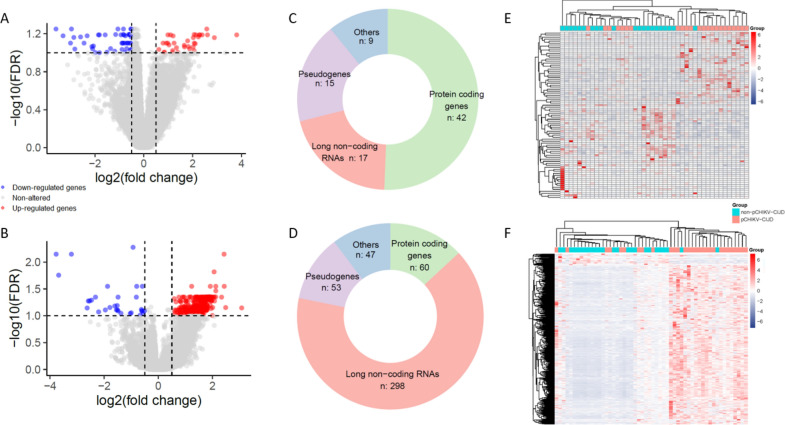Transcriptomic insights into early mechanisms underlying post-chikungunya chronic inflammatory joint disease.
Chikungunya virus (CHIKV) infection often results in a chronic joint condition known as Post-Chikungunya Chronic Inflammatory Joint Disease (pCHIKV-CIJD). This condition disrupts individuals' daily lives and contributes to increased healthcare expenditure. This study investigated the molecular mechanisms underlying pCHIKV-CIJD development by analyzing RNA transcripts, including small RNAs, of whole blood from CHIKV-infected patients. By comparing patients who evolved to pCHIKV-CIJD with those who did not, we identified molecular signatures associated with chronification in acute and post-acute disease phases. These molecules were primarily associated with an altered immune response regulation. Notably, LIFR, an immune receptor that enhanced IL-6 transcription, was down-regulated in the acute phase of pCHIKV-CIJD patients, while its inhibitor, hsa-miR-98-5p, was up-regulated in these individuals. Other downregulated genes include members of immune mechanisms whose impairment can lead to a reduction in the first line of antiviral response, thereby promoting virus persistence for a longer period in these patients. Additionally, pCHIKV-CIJD patients exhibited reduced transcript levels of MMP8, LFT, and DDIT4, genes already implicated in the pathological process of other types of inflammatory arthritis and seemingly relevant for pCHIKV-CIJD development. Overall, our findings provide insights into the early molecular mechanisms involved in the chronification and highlight potential targets for further investigation.
Authors
Ramundo MS, da Fonseca GC, Ten-Caten F, Gerber AL, et al.
External link
Publication Year
Publication Journal
Associeted Project
Systems Immunology of Human Diseases
Lista de serviços
-
Gene regulatory and signaling networks exhibit distinct topological distributions of motifs.Gene regulatory and signaling networks exhibit distinct topological distributions of motifs.
-
Gene signatures of autopsy lungs from obese patients with COVID-19.Gene signatures of autopsy lungs from obese patients with COVID-19.
-
Network Medicine: Methods and ApplicationsNetwork Medicine: Methods and Applications
-
ACE2 Expression Is Increased in the Lungs of Patients With Comorbidities Associated With Severe COVID-19.ACE2 Expression Is Increased in the Lungs of Patients With Comorbidities Associated With Severe COVID-19.
-
Drug repositioning for psychiatric and neurological disorders through a network medicine approach.Drug repositioning for psychiatric and neurological disorders through a network medicine approach.
-
Linking proteomic alterations in schizophrenia hippocampus to NMDAr hypofunction in human neurons and oligodendrocytes.Linking proteomic alterations in schizophrenia hippocampus to NMDAr hypofunction in human neurons and oligodendrocytes.
-
In-depth analysis of laboratory parameters reveals the interplay between sex, age, and systemic inflammation in individuals with COVID-19.In-depth analysis of laboratory parameters reveals the interplay between sex, age, and systemic inflammation in individuals with COVID-19.
-
The evolution of knowledge on genes associated with human diseasesThe evolution of knowledge on genes associated with human diseases
-
Network vaccinology.Network vaccinology.
-
Pyruvate kinase M2 mediates IL-17 signaling in keratinocytes driving psoriatic skin inflammationPyruvate kinase M2 mediates IL-17 signaling in keratinocytes driving psoriatic skin inflammation
-
Transcriptome analysis of six tissues obtained post-mortem from sepsis patientsTranscriptome analysis of six tissues obtained post-mortem from sepsis patients
-
Gene Signatures of Symptomatic and Asymptomatic Clinical-Immunological Profiles of Human Infection by Leishmania (L.) chagasi in Amazonian BrazilGene Signatures of Symptomatic and Asymptomatic Clinical-Immunological Profiles of Human Infection by Leishmania (L.) chagasi in Amazonian Brazil
-
In vitro morphological profiling of T cells predicts clinical response to natalizumab therapy in patients with multiple sclerosis.In vitro morphological profiling of T cells predicts clinical response to natalizumab therapy in patients with multiple sclerosis.
-
Integrative immunology identified interferome signatures in uveitis and systemic disease-associated uveitis.Integrative immunology identified interferome signatures in uveitis and systemic disease-associated uveitis.
-
Gene regulatory networks analysis for the discovery of prognostic genes in gliomas.Gene regulatory networks analysis for the discovery of prognostic genes in gliomas.
-
Revealing shared molecular drivers of brain metastases from distinct primary tumors.Revealing shared molecular drivers of brain metastases from distinct primary tumors.

